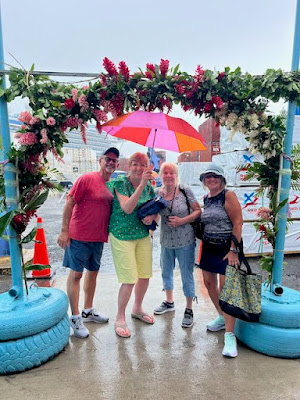Nestled on the northern coast of Samoa’s Upolu Island, Apia is a vibrant city steeped in history and cultural significance.
Founded in the 1850s, Apia officially became Samoa’s capital in 1953, serving as a center of governance, commerce, and culture.
A Harbor of Heroes and Tragedies
Apia’s harbor holds a dramatic chapter of 19th-century history. On March 15, 1889, it was the site of a naval standoff among Germany, the United States, and Britain. Despite a brewing typhoon, none of the seven ships would vacate the harbor for fear of appearing weak. The storm devastated the fleet, with only the British cruiser Calliope escaping intact. Nearly 200 lives were lost in this tragic clash of pride and nature.
An Unforgettable Stop in Apia
On Friday, November
15, 2024, the Grand Princess docked in Apia, Samoa, marking the start of an
unforgettable day.
My primary goal? Visiting the Robert Louis Stevenson Museum, a must-see for history and literature enthusiasts alike.
The port buzzes with transportation options—buses, vans, and taxis—ready to take you wherever you’d like to go. However, a little negotiation can make a big difference! My first taxi driver quoted $50 USD for a one-way ride to the museum for four people, but after some friendly bargaining, I secured a cab for $20 USD.
Pro Tip: Always agree on the fare before hopping into a taxi. Drivers are generally friendly and open to negotiation, so don’t hesitate to shop around.
A Tribute to Robert Louis Stevenson
Apia is home to the Robert Louis Stevenson Museum, a tribute to the famed Scottish writer known for classics like “Treasure Island”, “Strange Case of Dr. Jekyll and Mr. Hyde” and “Kidnapped”.
 |
| Robert Lewis Stephenson (1850-1894) |
Seeking relief from tuberculosis, Stevenson first visited Samoa in 1889 and returned in 1890 to live permanently in Vailima, just above Apia.
 |
| Vailima, Robert Lewis Stephenson home in Apia, Samoa |
Stevenson’s mansion, built with imported timber and intricate finishes, is a testament to his love for the island. The museum’s highlights include Stevenson’s study, adorned with wallpaper crafted from traditional Samoan tapa bark cloth. The craftsmanship is extraordinary and reflects the labor-intensive nature of this art.
 | |
| Tapa room |
The 30-acre property surrounding the museum is now the Vailima Botanical Garden, showcasing both ornamental and native Samoan plant species. A visit to the museum typically takes about 1.5 hours, but if you’re feeling adventurous, consider hiking to Stevenson’s tomb on Mount Vaea for panoramic views of Apia.
 |
| Gravesite on Mount Vaea |
Practical Information for Visiting the Museum
- Prices: Adults SAT$20; Children under 12 SAT$5; Students SAT$10
- Hours: Monday to Friday: 9 AM - 4:30 PM; Saturday: 9 AM - Noon; Sunday: Closed.
A Tropical Climate and Vibrant Economy
Apia’s tropical rainforest climate brings warm temperatures year-round, averaging 79°F (26°C). Rainfall peaks between December and March, while the driest months are July and August.
The city’s economy is a unique blend of local and international influences. Approximately 30% of downtown businesses are owned by a single Chinese family, with Europeans accounting for 10%, and Samoans owning the remaining 60%. This diversity adds to the city’s dynamic character.
Note: Always carry your umbrella when visiting Apia.
 |
| L-R: Rob Loft, Sharon Sparlin, Marci Inman, Janice Loft |
Navigating Apia
Traveling around Apia is straightforward, thanks to its well-maintained roads. In 2009, Samoa transitioned to driving on the left-hand side, aligning with many other Pacific nations. Whether you’re walking historic streets, visiting cultural landmarks, or enjoying its tropical ambiance, Apia offers an enriching and unforgettable experience.
From its storied past to its vibrant present, Apia offers a blend of history, culture, and natural beauty. Whether you’re a history buff, a literary fan, or simply looking to soak in Samoa’s tropical charm, Apia is sure to leave a lasting impression.
#TAHITI 2024 #Grand Princess #Robert Lewis Stephenson #Apia Samoa

.jpeg)

















No comments:
Post a Comment